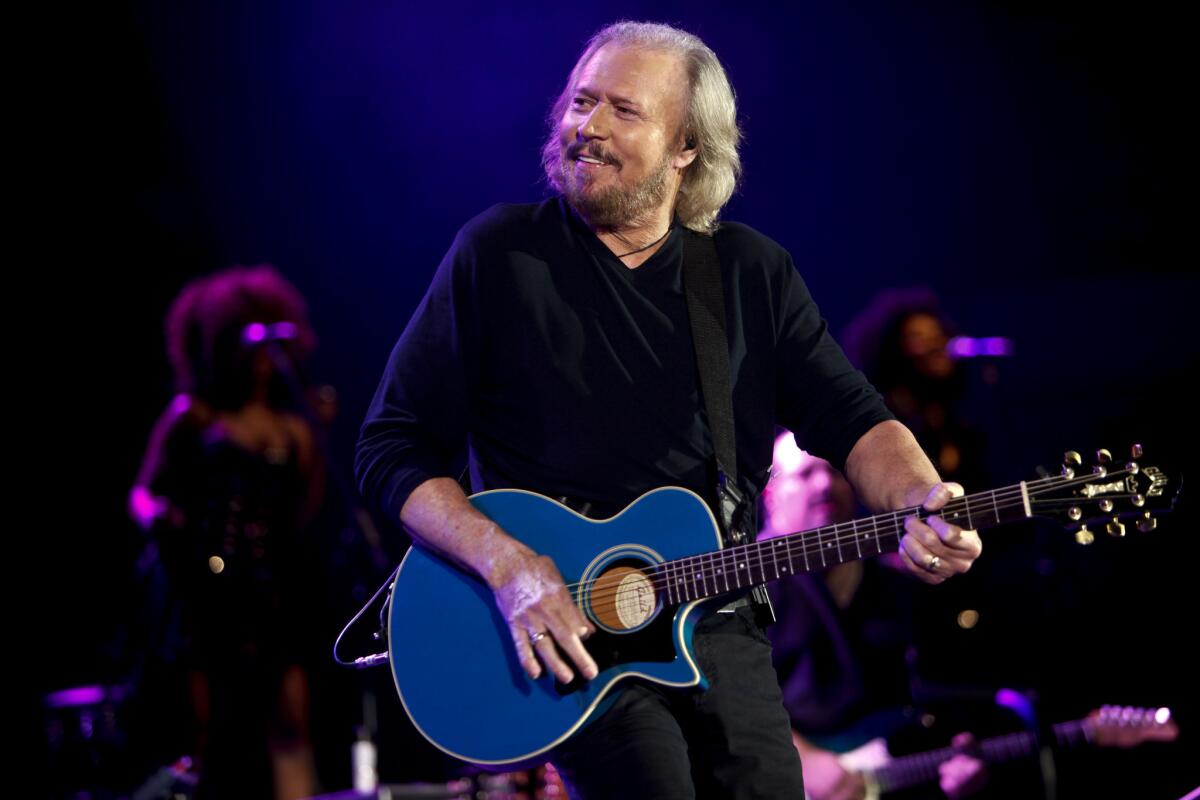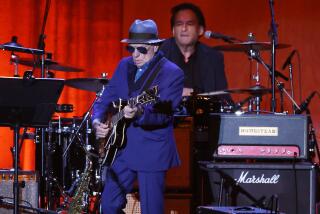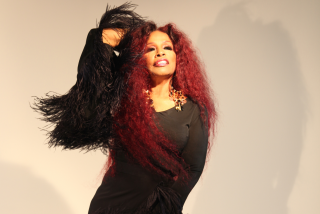Review: Barry Gibb: A broken heart mended at the Hollywood Bowl

Does anyone wear his legend status as lightly as Barry Gibb?
On Wednesday night, the Bee Gees frontman hit the Hollywood Bowl for the final stop of his Mythology Tour, a brief run of solo concerts designed to showcase the breadth (and depth) of the music he made with his late brothers, Robin and Maurice.
But if the succession of undeniable songs demonstrated Gibbâs huge effect on pop -- weâre talking âTo Love Somebody,â âHow Deep Is Your Loveâ and, of course, the immortal âStayinâ Aliveâ here -- he wasnât making a big deal about it.
âThe last of six,â he said by way of introduction, referring with an easy chuckle to the number of his U.S. tour dates. âThen I go watch television.â
The lightness of Gibbâs manner was especially remarkable given the heavy toll evidently taken by his brothersâ deaths. (Maurice died in 2003, Robin in 2012; a third brother, Andy, died in 1988.)
âWhen suddenly youâre on your own after all those years,â he said in a recent Rolling Stone profile, âyou start to question life itself. Whatâs the point in any of it?â
Memories of his siblings coursed through the 2½-hour show in the form of photographs and videos; Robin appeared on a large screen above the stage to sing âI Started a Joke.â Other Gibb family members took part, as well, including Mauriceâs daughter Samantha, who harmonized with Barry in âHow Can You Mend a Broken Heart,â and Barryâs son Stephen, who played guitar in the 11-piece band.
Gibb even admitted that his daughter Ali was on the road operating his teleprompter.
Rather than weigh him down, though, these reminders seemed to buoy Gibb, an infrequent performer these days. They added to the sense that Wednesdayâs show was more or less an extended jam session that mightâve broken out anywhere.
Nor was he slowed by the freight the Bee Geesâ music has taken on since the trioâs disco-era heyday -- the caricaturization of their hairstyles and clothing and the knee-jerk associations with show-business excess.
At the Bowl, âJive Talkinâ â and âNight Feverâ sounded as lithe and as effervescent as ever with Gibbâs aerated falsetto skipping over grooves that still suggest a kind of perpetual motion. Even âStayinâ Alive,â with four guitarists urging the music ever forward, felt unburdened by history.
Perhaps thatâs because so much current pop looks back to what the Bee Gees were doing in the late 1970s. Daft Punkâs âGet Lucky,â Pharrellâs âHappy,â âTake Back the Nightâ by Justin Timberlake (who has portrayed Robin Gibb in a recurring sketch on âSaturday Night Liveâ) -- even now these songs run a serious Saturday night fever.
Here again, though, Barry Gibb wasnât seizing an opportunity in the manner of a more calculating veteran. He hardly seemed driven by the desire to reach new listeners, which is probably why he spent a sizable portion of his set on lesser-known songs such as the gently psychedelic âSpicks and Specks,â one of the Bee Geesâ earliest singles. (He also did hits from the groupâs pre-disco period including âIâve Gotta Get a Message to Youâ and âTo Love Somebody.â)
The show had its saggy moments. An overblown rendition of âGuilty,â Gibbâs supple 1980 duet with Barbra Streisand, sacrificed the recordâs pillow-talk delicacy. And though it clearly meant a great deal to Gibb, Robinâs video appearance actually felt slightly ghoulish.
But right when youâd expect him to bog down -- in a cover of âIâm on Fireâ by Bruce Springsteen, who Gibb said had done âStayinâ Aliveâ at a recent tour stop in Australia -- he maintained the sense of weightlessness that distinguished Wednesdayâs performance.
Restraining his voice to a breathy flicker as his band murmured behind him, Gibb sang more quietly than he had sung anything else all night, barely touching the melody, as though he were frightened of its intensity or what it might evoke.
It was beautiful and spooky and just the slightest bit sad -- amazing, really. And it was over before you knew it.
More to Read
The biggest entertainment stories
Get our big stories about Hollywood, film, television, music, arts, culture and more right in your inbox as soon as they publish.
You may occasionally receive promotional content from the Los Angeles Times.











